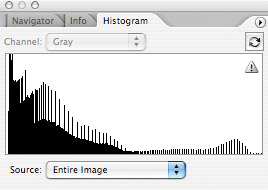Preventing Blown-Out Highlights and Plugged-Up Shadows
Because the height of the bars indicates how prevalent each shade is within your image, tall spikes on the ends of the histogram indicate that the image contains large quantities of white or black (Figure 6.78). That is usually an indication that you don't have any detail in the brightest or darkest areas of the image (Figure 6.79). If your image contains shiny areas that reflect light directly into the camera (like shiny metal or glass), then it's OK if those areas end up with no detail. But if that's not the case, then part of your curve must have topped or bottomed out. You should think about moving that area of the curve away from the top or bottom so you can get back the detail that was originally in that part of your image (Figures 6.80 and 6.81).
Figure 6.78. This histogram indicates that black and white take up a lot of space in the image.

Figure 6.79. This image does not contain detail in the highlights or shadow areas. (©2005 Andy Katz)

Figure 6.80. The histogram no longer has spikes on the ends after adjusting the curve to prevent topping or bottoming out.

Figure 6.81. The result of preventing the curve from bottoming or topping out.

